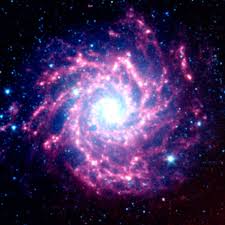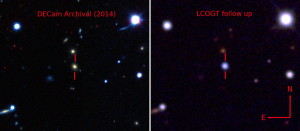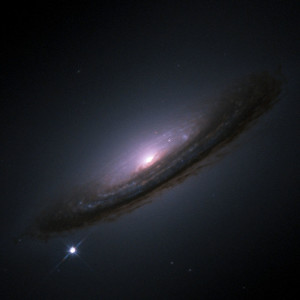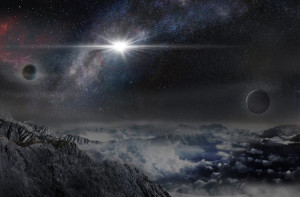Cosmic Explosion 570 Billion Times Brighter Than the Sun : A Well Thought Out Scream by James Riordan

It was last June when a team of astronomers employing a network of telescopes across the globe spotted an unusually bright object. Since then they have been investigating the phenomena and have now issued a report indicating they have discovered the most powerful supernova on record.
An artist’s impression of the supernova ASASSN- 15lh as it would appear from an exoplanet about 10,000 light-years away. CreditWayne Rosing
A supernova is a rare astronomical event that occurs during the last stages of a massive star‘s life, whose dramatic violent and catastrophic destruction is marked by one final titanic explosion. For a short time, this causes the sudden appearance of a ‘new’ bright star in the heavens, before slowly fading from sight over several weeks or months.
Pictured at right is an example of a supernova which some call “God’s Eye” for obvious reasons.
Theoretical studies of many supernovae show they can be triggered by one of two basic mechanisms. This can be by sudden re-ignition of nuclear fusion in a degenerate star; or by the sudden gravitational collapse of the massive star’s core. In the first instance, a degenerate white dwarf may accumulate sufficient material from a binary companion, either through accretion or via a merger, to raise its core temperature to then trigger runaway nuclear fusion, completely disrupting the star. In the second case, the core of a massive star may undergo sudden gravitational collapse, releasing gravitational potential energy that can create a supernova explosion. Observations do show there are more uniqueness or complexities to these two simple alternatives mechanisms, but the astrophysical collapse mechanics have been accepted and established by most astronomers for some time.
 The supernova ASAS-SN15lh brightened its host galaxy considerably: here, a 2014 false-color view of the galaxy from the Dark Energy Camera in Chile and one from the Las Cumbres Observatory Global Telescope Network in 2015, after the supernova’s peak.
The supernova ASAS-SN15lh brightened its host galaxy considerably: here, a 2014 false-color view of the galaxy from the Dark Energy Camera in Chile and one from the Las Cumbres Observatory Global Telescope Network in 2015, after the supernova’s peak.
Credit: The Dark Energy Survey, B. Shappee and the ASAS-SN team
While your average supernova generates roughly 1044 joules of energy — about the same amount that our sun produces over 10 billion years — a super-luminous supernova, like the one discussed here, can explode with up to 50 times more energy. This particular super-luminous supernova, called ASASSN-15lh, doesn’t just break the record for most powerful — it obliterates it. On average, it outshines the average supernova by 200 times, the team reported in a paper published in this week’s issue of Science.
 This goes so beyond the norm that one of the astronomers who first observed it wasn’t sure what to make of it. “To my surprise, I was not able to even tell for sure it was a supernova. My first reaction was: ‘This is interesting, we should get more data,'” Nidia Morrell, who works with the Las Campanas Observatory in Chile and is a co-author on the paper, said in a press release. “It was only when we obtained higher resolution [data] from the Southern African Large Telescope and the Magellan Clay Telescope that I realized how distant the host galaxy is and consequently, how luminous the supernova.”
This goes so beyond the norm that one of the astronomers who first observed it wasn’t sure what to make of it. “To my surprise, I was not able to even tell for sure it was a supernova. My first reaction was: ‘This is interesting, we should get more data,'” Nidia Morrell, who works with the Las Campanas Observatory in Chile and is a co-author on the paper, said in a press release. “It was only when we obtained higher resolution [data] from the Southern African Large Telescope and the Magellan Clay Telescope that I realized how distant the host galaxy is and consequently, how luminous the supernova.”
Unfortunately, we could never have hoped to see the explosion with our naked eye because its source is so distant — it’s coming from a galaxy 3.8 billion light years away. Here’s what that galaxy looked like, through a telescope, before (left) and after (right) the explosion:
The network of telescopes, named the All Sky Automated Survey for Supernovae (ASASSN), is meant to sniff out bright objects like these, and has discovered over 250 supernova. At peak intensity, astronomers calculated the signal to be shining with a mind-boggling intensity of 570 billion times brighter than our sun. For a better idea of how bright that is, if you could combine all 100 billion stars in our Milky Way Galaxy into one enormous, glowing sphere, this super-luminous supernova would still shine 20 times brighter.
 “We have to ask, how is that even possible?” Krzysztof Stanek, who is the team’s co-principal investigator and a professor at Ohio State University, said in a press release. “It takes a lot of energy to shine that bright, and that energy has to come from somewhere.” Stanek’s question gets at the heart of a mystery that’s been perplexing astronomers for over a decade, ever since they first began searching the skies for these super-luminous events at the end of the ’90s. They want to know what physical processes are at work that cause explosions so beyond anything we can fathom on Earth.
“We have to ask, how is that even possible?” Krzysztof Stanek, who is the team’s co-principal investigator and a professor at Ohio State University, said in a press release. “It takes a lot of energy to shine that bright, and that energy has to come from somewhere.” Stanek’s question gets at the heart of a mystery that’s been perplexing astronomers for over a decade, ever since they first began searching the skies for these super-luminous events at the end of the ’90s. They want to know what physical processes are at work that cause explosions so beyond anything we can fathom on Earth.
Generally, astronomers think they have a good handle on what causes your average supernova, but when it comes to hypernovae (another name for super-luminous supernova), they’re somewhat stumped. “The honest answer is, at this point, that we do not know what could be the power source for ASASSN-15lh,” Subo Dong, the paper’s lead author and an astronomy professor at Kavli Institute for Astronomy and Astrophysics at Peking University, told Ohio State.
 One theory is that a type of extremely dense star, called a neutron star, is at the source of it all. Neutron stars are some of the densest objects in the universe and are thought to be the only thing that’s left of a star once it’s gone supernova.
One theory is that a type of extremely dense star, called a neutron star, is at the source of it all. Neutron stars are some of the densest objects in the universe and are thought to be the only thing that’s left of a star once it’s gone supernova.
Many neutron stars are believed to be spinning on their axis — the same way Earth rotates on its axis. And in some neutron stars, the spinning action is so fast that it spawns powerful magnetic fields. Astronomers call these cases magnetars.
One theory is that the magnetic fields of magnetars are so strong that they could fuel the power necessary to generate the intense luminosity of observed hypernova. But if this is the case, it would also mean that in order to produce the type of luminosity seen from ASASSN-15lh, the magnetar would have to be spinning at 1,000 times a second.
“Given those constraints,” Todd Thompson, who is professor of astronomy at Ohio State but wasn’t part of the team, said in a press release. “Will we ever see anything more luminous than this? If it truly is a magnetar, then the answer is basically no.”
That means that there may never be a supernova this bright again and that is something to think about.
___





No Comment